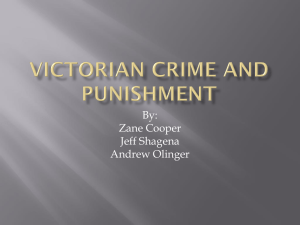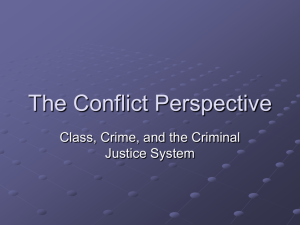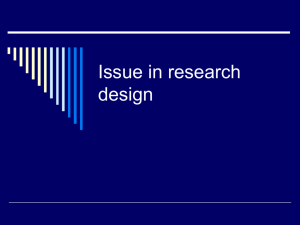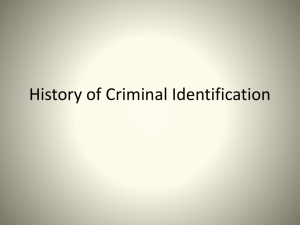File - Cameron M Parks
advertisement
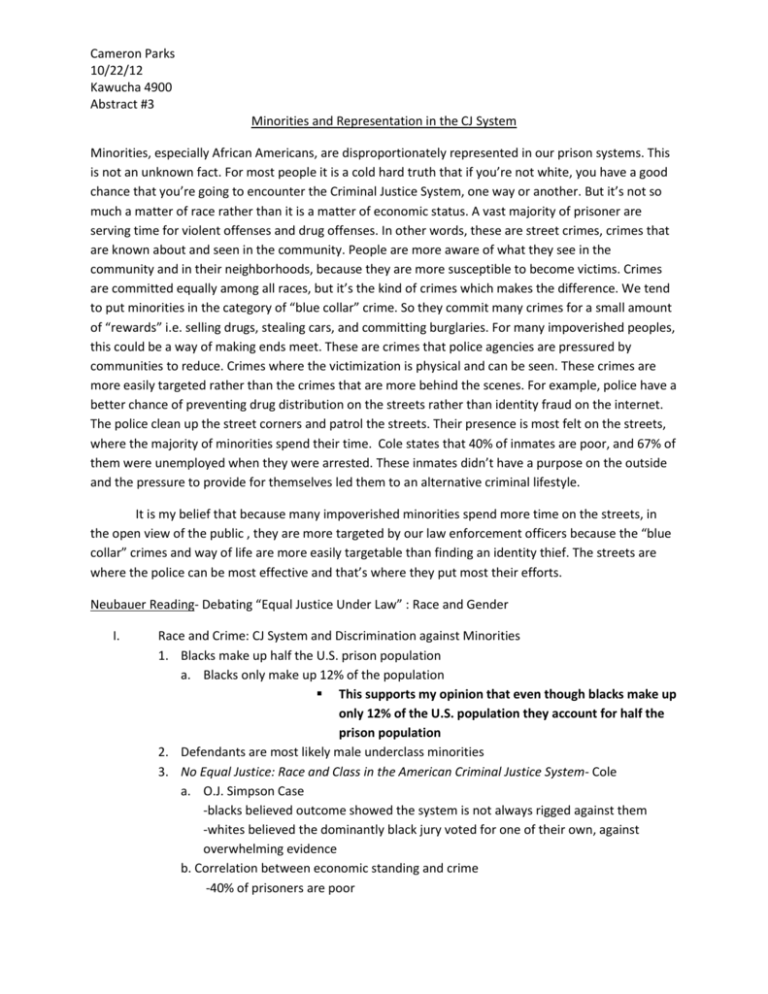
Cameron Parks 10/22/12 Kawucha 4900 Abstract #3 Minorities and Representation in the CJ System Minorities, especially African Americans, are disproportionately represented in our prison systems. This is not an unknown fact. For most people it is a cold hard truth that if you’re not white, you have a good chance that you’re going to encounter the Criminal Justice System, one way or another. But it’s not so much a matter of race rather than it is a matter of economic status. A vast majority of prisoner are serving time for violent offenses and drug offenses. In other words, these are street crimes, crimes that are known about and seen in the community. People are more aware of what they see in the community and in their neighborhoods, because they are more susceptible to become victims. Crimes are committed equally among all races, but it’s the kind of crimes which makes the difference. We tend to put minorities in the category of “blue collar” crime. So they commit many crimes for a small amount of “rewards” i.e. selling drugs, stealing cars, and committing burglaries. For many impoverished peoples, this could be a way of making ends meet. These are crimes that police agencies are pressured by communities to reduce. Crimes where the victimization is physical and can be seen. These crimes are more easily targeted rather than the crimes that are more behind the scenes. For example, police have a better chance of preventing drug distribution on the streets rather than identity fraud on the internet. The police clean up the street corners and patrol the streets. Their presence is most felt on the streets, where the majority of minorities spend their time. Cole states that 40% of inmates are poor, and 67% of them were unemployed when they were arrested. These inmates didn’t have a purpose on the outside and the pressure to provide for themselves led them to an alternative criminal lifestyle. It is my belief that because many impoverished minorities spend more time on the streets, in the open view of the public , they are more targeted by our law enforcement officers because the “blue collar” crimes and way of life are more easily targetable than finding an identity thief. The streets are where the police can be most effective and that’s where they put most their efforts. Neubauer Reading- Debating “Equal Justice Under Law” : Race and Gender I. Race and Crime: CJ System and Discrimination against Minorities 1. Blacks make up half the U.S. prison population a. Blacks only make up 12% of the population This supports my opinion that even though blacks make up only 12% of the U.S. population they account for half the prison population 2. Defendants are most likely male underclass minorities 3. No Equal Justice: Race and Class in the American Criminal Justice System- Cole a. O.J. Simpson Case -blacks believed outcome showed the system is not always rigged against them -whites believed the dominantly black jury voted for one of their own, against overwhelming evidence b. Correlation between economic standing and crime -40% of prisoners are poor Cameron Parks 10/22/12 Kawucha 4900 Abstract #3 II. 1. -67% of prisoners were unemployed when arrested This supports my opinion that poverty plays a major factor in inmates representation in prison -For every black man who graduates from college, 100 are arrested c. Administration of criminal law is predicated on the exploitation of inequality d. Criminal Law is color blind and class blind e. Systems of criminal justice - one for the privileged - another for the underprivileged 4. Race, Crime, and the Administration of Justice: A Summary of the Available Facts- Stone a. Minorities’ distrust of the CJ system in two ways - historical experience - present-day practice b. More than 80% of homicides where the killer was known is white on white or black on black c. Most crime committed by whites, young adults that commit crimes is equal among races, and community conditions seems to be the reason that crime falls so heavily on some groups This supports my opinion that even though crimes are committed equally among all the races, it’s what the community views as more severe crimes that leads to convictions d. Black defendants receive consistently more prison sentences than whites e. Reasons for optimism - In the last 20 years, domestic homicide has decreased to 1/7th what it was for black domestic homicide - Black male victims has dropped from 16 to fewer than 3 per 100,000 - Black female victims has dropped from 12 to fewer than 5 per 100,000 Gender and Justice: Is the Justice System Biased against Women? Sex on the Docket: Reports of State Task Forces on Gender Bias- Kearney and Sellers a. 1970’s Women made up 15% of attorneys and 4% of Judges b. 1980’s rise of NOW Legal Defense and Education Fund and National Association of Women Judges c. NAWJ created the National Judicial Education Program d. Women in courtrooms are judged by appearance and clothing e. Men are also discriminated against in court, for example custody battles for children f. Women are discouraged to report sexual assault depending on their social standing and virtuosity g. Florida task force’s two kinds of rape - Real rapes and those prompted by the victim Cameron Parks 10/22/12 Kawucha 4900 Abstract #3 h. Juveniles are treated differentially by gender - Boys receive more lenient treatment compared to girls - Girls are institutionalized more often and receive longer sentences - Fewer facilities and counseling programs for girls i. 95% of female court employees were in the lowest pay grades j. Although women made up 43% of admissions in law schools, female students are subjected to stereotyping and teasing 2. Women in Prison: From Partial Justice to Vengeful Equity a. From 1980-1997 female inmate populations in federal prisons jumped from 20,000 to 80,000 b. From 1987-1996 women’s criminal activity increased 31% and women in prison increased by 160% c. BJS reported the major reason for the growth of women in prisons is drug offenses - 1979 one in ten women were in prison for drugs - Today women in prison for drug offenses makes up 37.4 % d. Policy changes in the CJ system are suspected to be the reason for the increase in women’s imprisonment e. Prisons treating women like they do men, in the name of equality, seems vengeful - Arizona sheriff implements female chain gangs f. BJS reported 43% of women in prison have had some sort of physical or sexual abuse in their life before entering prison g. 1996 2/3rd of women in prison were serving time for drug offenses or property offenses h. 2/3rd of women in prison have at least one child under the age of 18 - Half have never received visits from their children i. Female prisons are unprepared - Unanticipated amounts of pregnant women - Sexual harassment of female inmates j. Since most female inmate are serving time for nonviolent offenses , possible use in the community services Decker Reading- Issue VIII Racial Profiling: Do the Police Target Minorities for Traffic Stops? 1. Montgomery Traffic Data Show Race Disparity- Ly a. Racial Profiling in Montgomery County - Blacks made up 15% of population in the county but made up 26% of the stops - Police claim its due to stops that they don’t have control over, i.e. radar and laser devices and red light violations b. NAACP claim officers are not recording their stops honestly and there is no way to check this c. Blacks were three times as likely to be asked if their vehicle could be searched - Of 450 searches, 197 were black drivers 2. Police Target Most Likely Criminals of All Races- Oliver Cameron Parks 10/22/12 Kawucha 4900 Abstract #3 a. Increased pressure on police agencies to reduce violent crime and enforce drug laws have led these agencies to adopt aggressive strategies - Leads to disparate treatment of blacks in impoverished neighborhoods b. Most minorities participate in street crime which is most targeted by the police , i.e. street corners c. Richmond- of 74 homicides in 1999, 87% of victims were black and 89% of suspects were black d. Effective crime reductions strategies are structurally targeted toward certain groups, based on fact rather than malice
